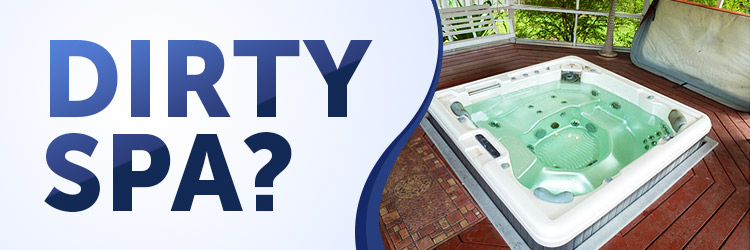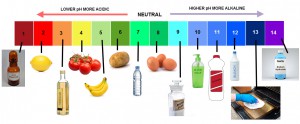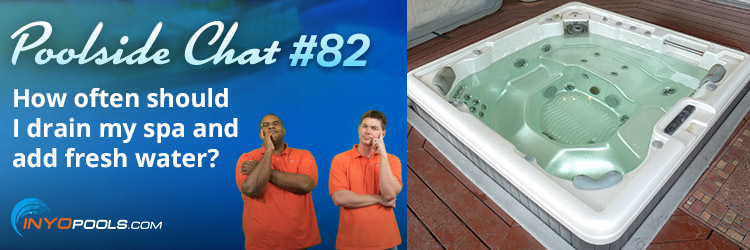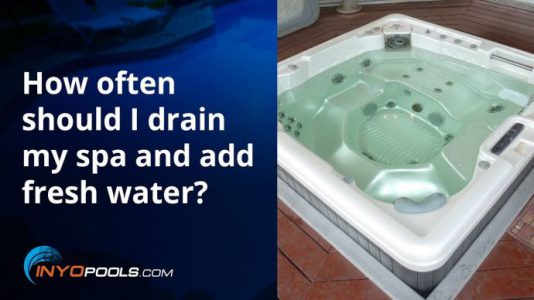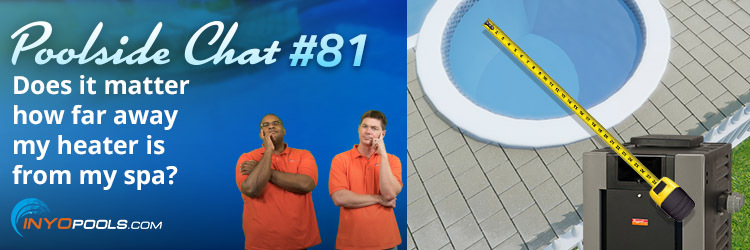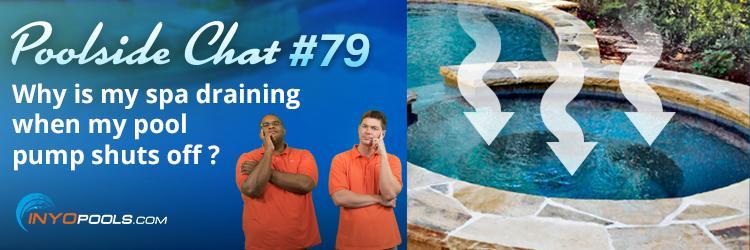Hello and welcome to the third installment of my spa refill. In my previous posting, we showed the original decrepit state of my spa after several months of lapsed maintenance. In the first blog, I gave an explanation of what happened, why it happened and what was going to happen to get it back up and running. In the second blog we purged the spa, drained it, re-glossed the shell, and refilled it. Now it is time for the easy part of balancing our spa water.
Freshwater presents an easier task of balancing its chemistry because of the clean slate it presents the chemicals. Spa owners will notice that the older the water becomes, the more “sluggish” it can be. This is due to the bather load and also chemicals added over the life of the water that have chemically saturated the water solution. This saturation causes a demand for more chemicals to be added to budge the chemical balance one way or another. When your water becomes sluggish it is a sign that it the spa should be purged, drained and refilled.
Quick recap: We are picking up after we have completed a purge of the old spa water, drained the shell, re-glossed it and added fresh water. While refilling, we used a metal sequester additive (Metal-Gon) to rid our source water of metals that can stain the spa’s surfaces or damage its heater.
Weapons of Mass Sanitation
We have “fresh water” but it is not bather ready just yet. Though the water has been treated and is safe to drink, it is not up to spa sanitation standards. Spas are normally around 500 gallons; a two person bather load is equal to 150 people in an average sized swimming pool. The high concentration of body oils, lotions and other organic debris demands we pull out the big guns to keep our spa clean. To make it simple, I am going to run through the group of chemicals as I added.
Balancers
Possibly your first inclination when refilling your spa is to chuck some chlorine in there to purify the water and then adjust the pH. After all, chlorine is all powerful and knowing, right? Sadly, no. This is where the the balancers come in. Chlorine needs help in fighting the microbes and bacteria infesting your spa water. Even Mister Fantastic needed three other team members. The elemental pool or spa building blocks for clean water are the pH,Total Alkalinity, and Calcium Hardness. These three, along with chlorine form a fantastic foursome no bacteria can withstand.
Recommended Balancer Ranges
| pH | 7.2 – 7.8 |
| Total Alkalinity | 80 – 120 ppm |
| Calcium Hardness | 150 – 400 ppm |
pH
The most mentioned of the balancers, and also the most likely to fluctuate, is the spa’s pH. A spa’s pH level is to be maintained between 7.2 – 7.8 on the 0 – 14 scale. As seen on the scale below, the lower the pH number the more acidic; the higher it goes, the more alkali (base) it becomes. Tap water is around a 7.0 on the scale, but for our spa we need to be at the 7.2 – 7.8. Too low and the water becomes acidic and corrosive, and too high the water will cause scaling and damage plumbing.
To balance, we will use pH increaser or decreaser as our spa requires. Leisure Time provided Spa Up and Spa Down in their Deluxe Maintenance Package.
Total Alkalinity
The key to a balanced pH is a well maintained alkalinity level. Alkalinity acts as a catalyst and buffer for the pH, keeping it it within its 7.2 – 7.8 range. The pH of a spa may raise or dip naturally but that is a sign the alkalinity is doing its job in preventing extreme spikes and valleys. The recommended range for your spa total alkalinity is 80 – 120 PPM. We will use alkalinity increaser to adjust the water chemistry as needed.
Once the pH and Alkalinity are balanced, I used Leisure Time’s pH Balance Plus to lock in both until the next spa refill. The pH will be locked in but the alkalinity may slip out of the 80 – 120 ppm range. Do not attempt to adjust the alkalinity. The special balancers within Balance Plus will adjust to keep your spa in check.
Calcium Hardness
Calcium hardness must be kept in the range of 150 – 400 ppm for spa use. Below the recommended range, the water becomes “soft” which can cause corrosion and excessive foaming. The soft water will attempt to draw its missing calcium from plumbing lines and the spa shell, making them brittle. A high calcium water solution will cause scaling as shown in the figure. Scaling will eventually clog and make brittle plumbing lines.
Calcium has a tendency to settle or cling to your spa equipment; this reaction is called scaling. To prevent the settling, we will use a sequestering agent that binds to the calcium to keep it solute. We will use a dosage of Defender as our calcium sequester.
Chlorine
Our balancing is complete and now it is time to bring out the sanitizer to finish the job. In this case, we will be using Leisure Time Spa 56 Granules and their non-chlor shock called Renew. Chlorine is the standard for sanitation in pools and also very common in spas due to its relative low cost and homeowner familiarity. The main disadvantage with chlorine is the mild smell and the skin and eye irritation produced when mixed with heavy bather loads in spa. Chlorine also can lose its cleaning effectiveness quicker than bromine in the heat of a spa. The decay rate of chlorine will cause the need for more maintenance over the installation of a spa but the cost is lower than bromine.
Renew Non-Chlor Shock
One last thing to do before we can take a soak and that is to shock our water with a non-chlor oxidizer. Shock is an oxidizing agent that collects and destroys organic materials such as body oils, lotions and other grime that chlorine can not kill on its own. Shock should be part of a spa maintenance routine. A spa should be dosed with non-chlor shock at least once a week and after each use. Non-chlor shock is not as skin irritating as chlorine shock which helps eliminate chlorine odors.
Spa Stick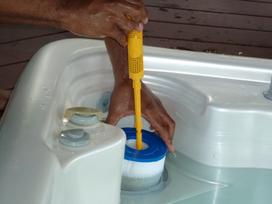
This little wand is packed to the gills with cleansing minerals that help reduce the spa’s need for chemicals for up to four months. The addition of a spa stick will create softer and cleaner spa water while also reducing the dreaded chlorine smell, and skin and eye irritation. Simply pop it in your cartridge opening and you are done until the next refill. I love it!
That about does it!
After this whole ordeal, I can tell you I will never let my spa get into such a state as when I started this blog. The work it took to get it in working condition could have been eliminated if I had kept to a weekly regimen. Do not let laziness become your guide when it comes to pool or spa maintenance. Less work now just leads to more work later.
Thanks for taking the time to read this series and if you have any further questions, please do not hesitate to call our techs for help. We can be reached at 877-372-6038
